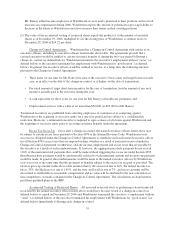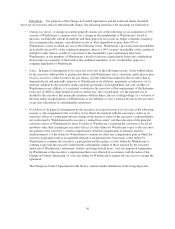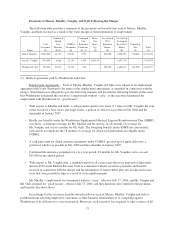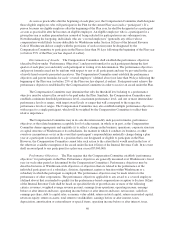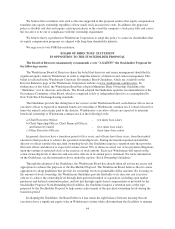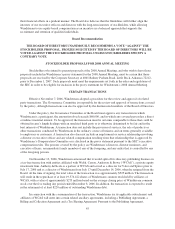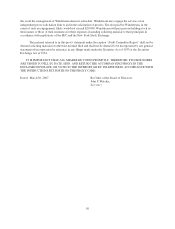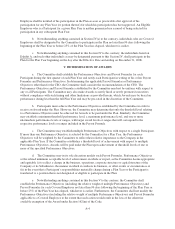Windstream 2006 Annual Report Download - page 48
Download and view the complete annual report
Please find page 48 of the 2006 Windstream annual report below. You can navigate through the pages in the report by either clicking on the pages listed below, or by using the keyword search tool below to find specific information within the annual report.
We believe that a retention ratio such as the one suggested in this proposal ensures that equity compensation
translates into equity ownership regardless of how much stock an executive owns. In addition, the proposed
policy is flexible and does not require catch-up purchases in the event the company’s stock price falls and causes
the executive to be out of compliance with the ownership requirement.
We believe that it is prudent for Windstream Corporation to adopt this policy to assure its shareholders that
its equity compensation programs are aligned with long-term shareholder interests.
We urge you to vote FOR this resolution.
BOARD OF DIRECTORS’ STATEMENT
IN OPPOSITION TO THE STOCKHOLDER PROPOSAL
The Board of Directors unanimously recommends a vote “AGAINST” the Stockholder Proposal for
the following reasons:
The Windstream Board of Directors shares the belief that directors and senior management should hold a
significant equity stake in Windstream in order to align the interests of directors and senior management. This
belief is reflected in the Windstream Corporate Governance Board Guidelines, which are available on the
Investor Relations page of the Windstream Corporation website at www.windstream.com/investors. In
furtherance of this belief, the Windstream Board has adopted Minimum Share Ownership Guidelines (the
“Guidelines”) for its directors and officers. The Board adopted the Guidelines upon the recommendation of the
Governance Committee of the Board, which is comprised solely of independent directors as contemplated by
New York Stock Exchange Listing standards.
The Guidelines provide that during his or her service on the Windstream Board, each director who is not an
executive officer is expected to maintain beneficial ownership of Windstream common stock valued at least five
times the annual cash retainer paid to the director. Windstream’s executive officers are expected to maintain
beneficial ownership of Windstream common stock at the following levels:
a) Chief Executive Officer - ten times base salary
b) Chief Operating Officer; Chief Financial Officer;
and General Counsel - five times base salary
c) Other Executive Officers - three times base salary
In general, directors have a transition period of five years, and officers have three years, from their initial
election to their position to achieve the specified ownership levels. During the transition period and until the
director or officer satisfies the specified ownership levels, the Guidelines impose a retention ratio that provides
that each officer and director is expected to retain at least 50% of shares received, net of tax payment obligations,
upon the vesting of restricted stock or the exercise of stock options. Each year Windstream will report on the
actual ownership levels of directors and executive officers in its annual proxy statement. For more information
on the Guidelines, see the information above under the caption “Stock Ownership Guidelines.”
Through the adoption of the Guidelines, the Windstream Board has already taken all actions necessary and
appropriate to achieve the purposes of the Stockholder Proposal. The Windstream Board believes that it is more
appropriate to adopt guidelines that provide for ownership levels in quantifiable dollar amounts. By focusing on
the amount of stock ownership, the Windstream Guidelines provide flexibility to its directors and executive
officers to achieve the ownership level through their preferred method of acquisition, including open market
purchases and defined contribution plans, and not just through equity-based compensation as provided by the
Stockholder Proposal. Notwithstanding this flexibility, the Guidelines impose a retention ratio of the type
proposed by the Stockholder Proposal to help ensure achievement of the specified ownership levels during the
transition period.
In adopting the Guidelines, the Board believes it has struck the right balance between insuring that our
executives have a significant equity stake in Windstream’s future while allowing them the flexibility to manage
44



